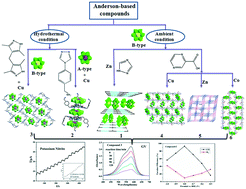A series of A- and B-type Anderson compounds with Al, Te and Cr as centers by tuning different ligands: syntheses, electrochemical, photocatalytic and CO2RR properties†
Abstract
Through the use of triazole and its derivative, two new Anderson-based compounds modified by multi-nuclear metal clusters, namely, {[ZnII5(trz)6(H2O)12][α-B-AlMo6(OH)6O18]2}·(α-B-HAlMo6(OH)6O18)·23H2O (1) and {[CuII3(tybm)3(H2O)4][α-A-TeMo6O24]}2·(α-A-H6TeMo6O24)·16H2O (2) (trz = 1,2,4-1H-triazole, tybm = 4-[1,3,4]triazol-4-yl-benzylamine), were synthesized under hydrothermal conditions. Furthermore, using a new bis(pyrazole) ligand and pyrazine-2-carboxylic acid (2-pyc), four mononuclear metal–organic subunits modified Anderson structures were obtained under ambient conditions, {CuI2(H2bdpm)2[α-B-HCr(OH)6Mo6O18]} (3), {[CuII2(2-pyc)2(H2O)4][α-B-HCr(OH)6Mo6O18]}·17H2O (4), {[ZnII2(2-pyc)2(H2O)2][α-B-HCr(OH)6Mo6O18]}·18H2O (5), and {[CoII(2-pyc)(H2O)2]2[α-B-HCr(OH)6Mo6O18]}·15H2O (6) (H2bdpm = 1,1′-bis(3,5-dimethyl-1H-pyrazolate)methane). Compounds 1, 3, 4 and 6 are 2D structures, while compound 5 is a 3D framework. Compound 2 is a trimer with three Anderson anions linked by two tri-nuclear [CuII3(tybm)3(H2O)4]6+ clusters. Among them, compound 3 shows the electrocatalytic performance toward inorganic ions and electrochemical sensing performances for nitrite. On the other hand, compounds 1–6 can be used as catalysts for organic dyes and carbon dioxide. For the photocatalytic activities of title compounds, compound 3 exhibits greater activity than other compounds. The conversion of compound 3 for MB, RhB and GV is 60.0%, 63.2% and 76.8%, respectively. For electrochemical catalysts on CO2RR, the maximum Faradaic efficiency of CO is 43.2% at −0.5 V (vs. RHE) for 1, 93.4% at −0.8 V (vs. RHE) for 2, 39.0% at −0.7 V (vs. RHE) for 3, 53.8% at −0.8 V (vs. RHE) for 4, 39.6% at −0.9 V (vs. RHE) for 5, and 41.2% at −0.6 V (vs. RHE) for 6. Results show that title compounds possess good electrochemical and catalytic performances.

- This article is part of the themed collection: Crystal Engineering Techniques


 Please wait while we load your content...
Please wait while we load your content...